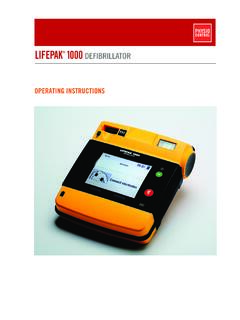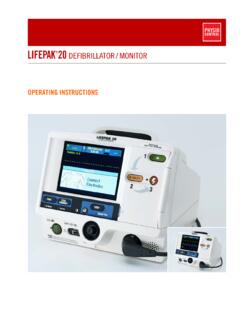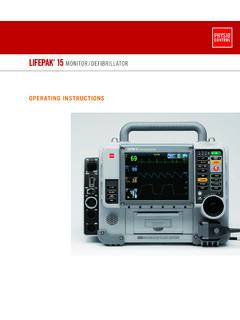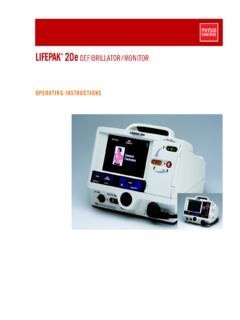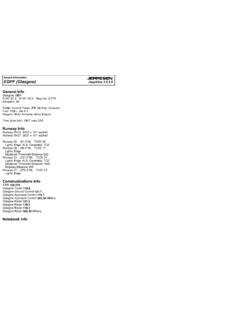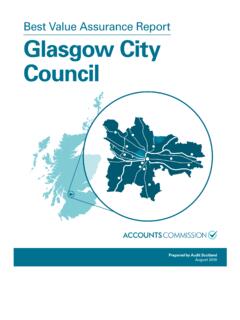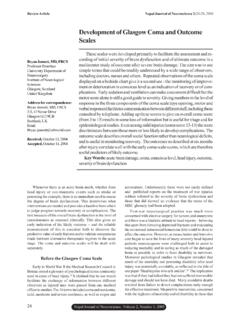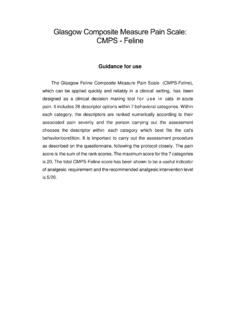Transcription of Glasgow 12-lead ECG Analysis Program - Physio …
1 For use with the LIFEPAK 15 MONITOR/DEFIBRILLATORPHYSICIAN S GUIDEG lasgow 12-lead ECG Analysis ProgramFor use with the LIFEPAK 15 MONITOR/DEFIBRILLATORPHYSICIAN S GUIDEG lasgow 12-lead ECG Analysis ProgramImportant Information Version HistoryGlasgow 12-lead ECG Analysis Program Version 27 is used in LIFEPAK 15 software version 3207410-006 and later versions. !USARxOnlyLIFEPAK is a registered trademark of Physio -Control, Inc. Specifications are subject to change without notice. 2009 Physio -Control, Inc. All rights reserved. Publication Date: 3/2009 GDR 3302437_A 2009 Physio -Control, Inc. Physician s Guide to the Glasgow 12-lead ECG Analysis Program iiiCONTENTS1 The Glasgow 12-lead ECG ProgramIntroduction .. 1-12 Acquisition, Measurement, and DiagnosisAcquisition .. 2-1 QRS typing .. 2-1 Selection of required QRS class .. 2-2 Averaging .. 2-2 Wave measurement .. 2-2 QRS components .. 2-4ST segment .. 2-4P and T 2-5 Interval measurements.
2 2-5 Normal 2-5 Diagnosis .. 2-6 Rhythm Analysis .. 2-6 Morphological Interpretation .. 2-7 References .. 2-93 Criteria for Interpretive StatementsMeasurement Reference .. 3-1P and T Wave Morphologies .. 3-2 Lead Reversal and Dextrocardia .. 3-3 Restricted Analysis ..3-4 Miscellaneous Preliminary 3-4 Heart Rate .. 3-5 Tachycardia .. 3-5 Bradycardia .. 3-5 Intervals .. 3-5PR 3-6QT 3-7 Atrial 3-8 QRS Axis Deviation .. 3-9 Conduction Defects .. 3-11 WPW Pattern ..3-15 Brugada 3-16 Hypertrophy .. 3-17 Left Ventricular 3-17 Right Ventricular Hypertrophy .. 3-20 Biventricular Hypertrophy .. 3-23 Myocardial Infarction .. 3-24 STEMI Criteria .. 3-24 Sgarbossa's Criteria .. 3-25Q Waves in Inferior or Lateral 3-26 Inferior Myocardial Infarction .. 3-28 Lateral Myocardial Infarction .. 3-29ivPhysician s Guide to the Glasgow 12-lead ECG Analysis Program Q Waves in Anteroseptal, Anterior, or Septal Leads .. 3-30 Anteroseptal Myocardial Infarction.
3 3-31 Anterior Myocardial 3-33 Septal Myocardial Infarction .. 3-35 Posterior Myocardial Infarction .. 3-37 Anterolateral Myocardial Infarction .. 3-38 Extensive Myocardial 3-39ST Abnormalities (Injury and Others) .. 3-40ST-T Abnormalities (Ischemia and Others) .. 3-44 Miscellaneous 3-51 Low QRS Voltages .. 3-51 Tall T Waves .. 3-51 Rhythm Statements .. 3-52 Dominant Rhythm Statements .. 3-52 Supplementary Rhythm 3-53 Rhythm Statement Additions .. 3-54 Summary Codes .. 3-554 Measurement MatrixMeasurement Matrix Definitions .. 4-1 Appendix A: Complete Statement ListPreliminary Comments ..A-1 Lead Reversal / Dextrocardia ..A-2 Restricted Analysis ..A-2 Miscellaneous Preliminary Statements ..A-2 Intervals ..A-2 Atrial Abnormalities ..A-2 QRS Axis Deviation ..A-3 Conduction Defects ..A-3 WPW Syndrome ..A-3 Hypertrophy ..A-4 Mycardial Infarction ..A-4ST Abnormalities ..A-6ST-T Changes (Ischemia) ..A-7 Miscellaneous - Low QRS Voltages.
4 A-9 Miscellaneous - Tall T Waves ..A-9 Dominant Rhythm Statements ..A-9 Supplementary Rhythm Statements ..A-12 2009 Physio -Control, s Guide to the Glasgow 12-lead ECG Analysis Program 1-11 The Glasgow 12-lead ECG ProgramIntroductionThe purpose of the Physician's Guide to the Glasgow 12-lead ECG Analysis Program is to provide readers with an understanding of how the Glasgow 12-lead ECG Analysis Program works with the LIFEPAK 15 monitor/defibrillator to acquire, measure, and interpret 12-lead ECG guide is intended for readers with varying levels of knowledge about ECG Analysis , from moderate to general overview of how the Program works is followed by a highly detailed section explaining the criteria used in the Program 's interpretive statements. See this guide s table of contents for an overview of topics in the order presented. References are cited in each a detailed explanation of the development and history of the Glasgow 12-lead ECG Analysis Program , see the Statement of Validation and Accuracy for the Glasgow 12-lead ECG Analysis Program , available from your Physio -Control representative or by calling 1-800-442-1142.
5 2009 Physio -Control, s Guide to the Glasgow 12-lead ECG Analysis Program 2-12 Acquisition, Measurement, and DiagnosisPresented in this chapter is a detailed description of how the Glasgow 12-lead ECG Analysis Program acquires and measures ECG data, and how diagnoses are methodology for ECG waveform measurement is described in general terms in an earlier publication from the Glasgow Ten seconds of ECG data is input to the software for Analysis and all leads require to have been acquired simultaneously. A 50 or 60 Hz notch filter is applied to the ECG data before sending it to the Glasgow Program to remove any AC interference. The first stage of the Analysis is to compute leads III, aVR, aVL, and aVF from the provided leads I and II. The ECG data is then filtered to minimize the effects of age and gender are also input to the Glasgow Program . If not entered, the default is a 50 year old male. Entry of patient age and gender are strongly encouraged for maximizing the accuracy of diagnostic statements, especially for acute ST elevation myocardial Glasgow Program can, for some statements, also use race and clinical classification ( , congenital heart disease) as inputs.
6 However, entry of race and clinical classification is not implemented in the LIFEPAK 15 next step in the Analysis is to calculate a form of spatial velocity combining the first difference of each this spatial velocity function, the approximate locations of all the QRS complexes are derived. Allowance has to be made for pacemaker stimuli, which are detected by the LIFEPAK 15 front end and passed to the Program in the form of a list of spike the QRS locations, it is then possible to check the quality of the recording for noise and baseline drift. If the drift is excessive, it is removed by using a cubic spline technique to obtain, for each lead affected, the baseline trend, which is then subtracted from the original data. If the noise is excessive, it is possible to remove a whole lead from the Analysis or, alternatively, five seconds of all leads are removed either from the first or second half of the acquired data is then measured by the Program , as described in the following typingThe various QRS complexes are typed according to their morphology.
7 An iterative process is used. 2-2 Physician s Guide to the Glasgow 12-lead ECG Analysis ProgramThe first complex in lead I is compared with the second using first differences of each cycle. The comparison takes the form of moving one beat over the other. When the difference is minimal, optimal alignment is present. This alignment point is used for the difference between beats is less than a threshold value, they are deemed to belong to the same class. The procedure is repeated with the third beat being compared with the second and so on. If a new morphology is detected, , if the threshold is exceeded, a new class is established. The procedure continues with five leads being used in the typing of required QRS classIf more than one class of beat is present, then a decision is made as to which morphology will be used for the averaging procedure. Complex logic is used for this purpose. The logic has to allow for a single normally conducted beat in the midst of demand pacemaker beats.
8 It also needs to take into account the QRS durations of different beat classes, RR intervals (to exclude extrasystoles), and to a limited extent the number of beats in each morphological net effect is to choose one class of beats, of a similar morphology, that are regarded as being conducted in the normal sequence through the beats in the selected class are averaged so that 12 beats, one from each lead, are then available. The average beat can be computed in different ways. The alignment points detected when wave typing was undertaken are used as reference points in the averaging average beat can be a straight average of all corresponding aligned points or a median calculated from the same practice, the Program forms the straight average, which is compared to individual beats in the same class. If there is a significant difference at any point, then the median beat is measurementFrom the 12 average beats, a single combined function is formed and a provisional overall QRS onset and termination is determined by thresholding techniques.
9 The provisional onset and termination are then used as starting points for a search for QRS onset and termination within each individual approach conforms to the recommendations of the CSE working party, of which one of the Glasgow team was a 2009 Physio -Control, s Guide to the Glasgow 12-lead ECG Analysis Program 2-3In each individual lead, the QRS onset is taken as the baseline and hence Q, R, S, R' waves are measured with respect to the QRS onset as shown in the accompanying figures from the CSE paper (see figures 2-1 through 2-4). Figure 2-1 Varying choice of baselinesFigure 2-2 Baseline at the level of QRS onset as used by the Glasgow programFigure 2-3 Isoelectric segments I and K2-4 Physician s Guide to the Glasgow 12-lead ECG Analysis ProgramFigure 2-4 Definitions for QRS end / ST junctionIsoelectric segments at the beginning of a QRS complex, for example, a flat segment between the provisional overall onset and the onset of an individual lead, are excluded from the first component (Q or R) of the QRS complex, as recommended by the CSE group.
10 Similar considerations apply at the end of the QRS complex (see Figure 2-3). A sorting algorithm is applied to all 12 onsets to determine the global QRS onset as follows. The earliest onset is excluded, and the next onset (one that also lies within 20 ms of the next) is selected as the overall onset. This ensures that any true outliers are excluded. The reverse process is used to find the overall QRS componentsWithin the QRS complex, the amplitude and duration of the various Q, R, S, R' waves are measured. In keeping with the CSE recommendations,2 the minimum wave acceptable has to have a duration > 8 ms and an amplitude > 20 V. With respect to global QRS duration, the Glasgow Program measures QRS duration from the global QRS onset to the global QRS termination. This means that an isoelectric segment within one particular QRS complex by definition will lead to a shorter QRS duration for that lead compared to the global QRS segmentThe ST segment has several measurements made.

